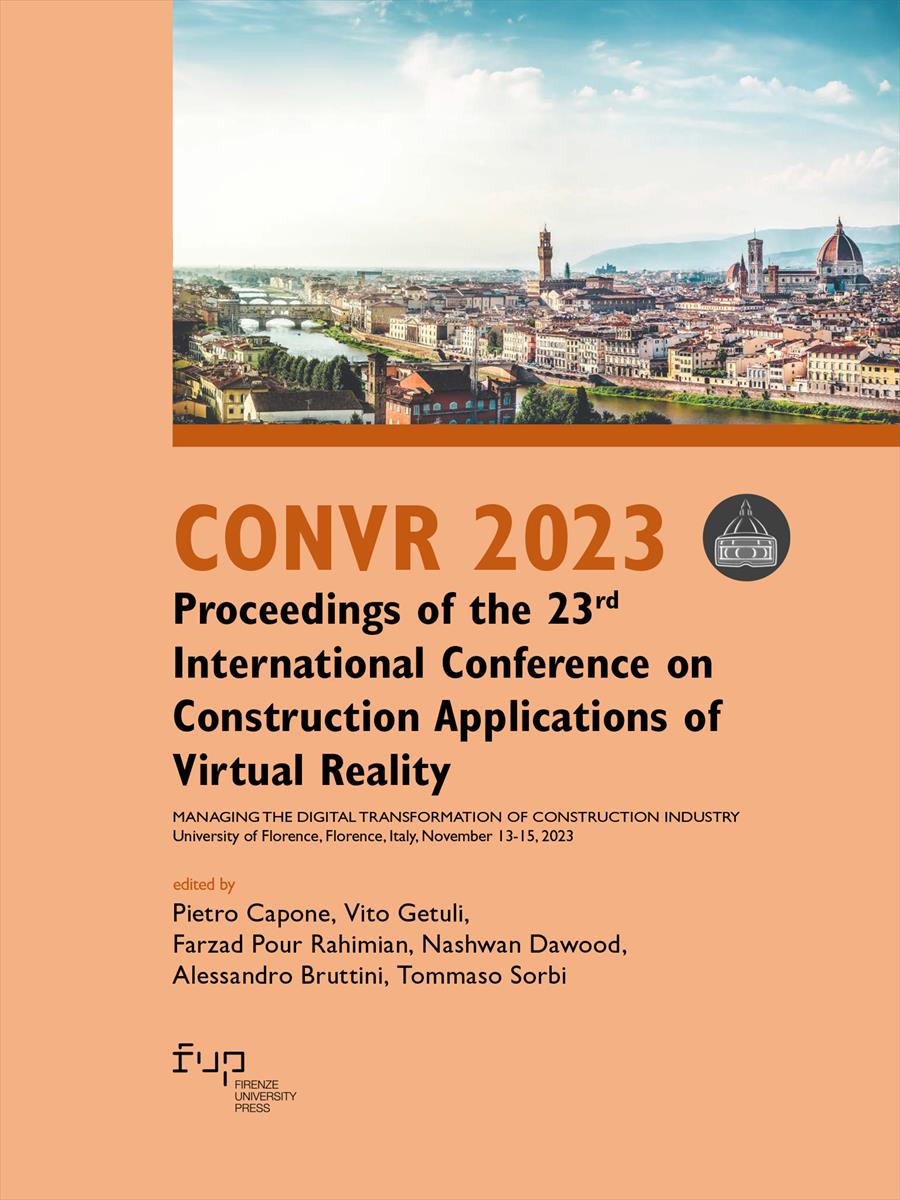- CONVR 2023 - Proceedings of the 23rd International Conference on Construction Applications of Virtual Reality
- A cura di Pietro Capone, Vito Getuli, Farzad Pour Rahimian, Nashwan Dawood, Alessandro Bruttini, Tommaso Sorbi
Data-Driven Construction and Operating Cost Decision Support Through Techno-Economic Analysis: Residential Case Study
- Panos Karaiskos
- Tulio Sulbaran
- © 2023 Author(s) |
- CC BY-NC 4.0
- DOI: 10.36253/979-12-215-0289-3.45
Construction and operating costs of residential buildings are important. Because, it can help designers, builders, owners, and renters make informed decisions about where and what to buy or rent. One of the most significant operating costs of residences is energy cost. More specifically, heating, ventilation, and air conditioning account for as much as 35% of the overall energy consumption of buildings in the world. Thus, the problem that this research paper addresses is the decision trade-off of construction costs vs. operating costs. Therefore, this paper aims to perform a techno-economic analysis of exterior residential wall-type alternatives in a warm-humid climate. The research followed a quantitative methodology using a virtual case study with multi-objective analysis. The results of this study show the significant importance of the building’s infiltration on the operational savings and the return on investment (ROI) of the different types of exterior residential walls. and emphasizes the importance of a holistic approach to energy conservation regulations. The novelty of this study is the emphasis on the importance of infiltration in pre-construction decision-making. The broader impact of this result is that the International Energy Conservation Code (IECC) and similar standards could be revised to reduce energy consumption and reduce greenhouse gas emissions produced during energy generation
- Keywords:
- Residential,
- Building Performance,
- Construction Cost Estimating,
- Insulation,
- Infiltration,
- Return on Investment,
- Decision Support,
The University of Texas at San Antonio, United States
The University of Texas at San Antonio, United States
- Abanda, F. H., & Byers, L. (2016). An investigation of the impact of building orientation on energy consumption in a domestic building using emerging BIM (Building Information Modelling). Energy, 97, 517–527. DOI: 10.1016/j.energy.2015.12.135
- Building Energy Codes Program, D. (2018). BUILDING ENERGY CODES www.energycodes.gov BUILDING ENERGY CODES PROGRAM Residential Provisions of the 2018 International Energy Conservation Code. www.energycodes.gov
- D’Agostino, D., de’ Rossi, F., Marigliano, M., Marino, C., & Minichiello, F. (2019). Evaluation of the optimal thermal insulation thickness for an office building in different climates by means of the basic and modified “cost-optimal” methodology. Journal of Building Engineering, 24. DOI: 10.1016/j.jobe.2019.100743
- Department of Energy, U. (2015). AN ASSESSMENT OF ENERGY TECHNOLOGIES AND RESEARCH OPPORTUNITIES Chapter 5: Increasing Efficiency of Building Systems and Technologies.
- electricityplans.com. (2023). Average cost of electricity in Texas. https://electricityplans.com/average-electricity-bill-in-texas/#:~:text=The%20average%20cost%20of%20electricity%20in%20Texas%20is%2014.63%20cents,both%20electricity%20and%20delivery%20costs.
- Energy Plus. (n.d.). Retrieved March 19, 2023, from https://energyplus.net/
- Farhanieh, B., & Sattari, S. (2006). Simulation of energy saving in Iranian buildings using integrative modeling for insulation. Renewable Energy, 31(4), 417–425. DOI: 10.1016/j.renene.2005.04.004
- Ghrab-Morcos, N. (2005). CHEOPS: A simplified tool for thermal assessment of Mediterranean residential buildings in hot and cold seasons. Energy and Buildings, 37(6), 651–662. DOI: 10.1016/j.enbuild.2004.09.020
- Huang, H., Zhou, Y., Huang, R., Wu, H., Sun, Y., Huang, G., & Xu, T. (2020). Optimum insulation thicknesses and energy conservation of building thermal insulation materials in Chinese zone of humid subtropical climate. Sustainable Cities and Society, 52. DOI: 10.1016/j.scs.2019.101840
- IECC. (2015). IECC DIGITAL CODES SECTION R402 BUILDING THERMAL ENVELOPE. IECC DIGITAL CODES. https://codes.iccsafe.org/s/IECC2015/chapter-4-re-residential-energy-efficiency/IECC2015-Pt02-Ch04-SecR402#:~:text=The%20building%20thermal%20envelope%20is,leakage)%20requirements%20of%20the%20code DOI: 10.1016/j.buildenv.2017.06.007
- Ji, Y., Duanmu, L., & Li, X. (2017). Building air leakage analysis for individual apartments in North China. Building and Environment, 122, 105–115.
- John Wiley & Sons. (2012). RSMeans cost data student edition.
- Kaynakli, O. (2012). A review of the economical and optimum thermal insulation thickness for building applications. In Renewable and Sustainable Energy Reviews (Vol. 16, Issue 1, pp. 415–425). DOI: 10.1016/j.rser.2011.08.006
- Kneifel, J. (2012). Prototype Residential Building Designs for Energy and Sustainability Assessment. DOI: 10.6028/NIST.TN.1765
- Ogulata, T., Tug, R., & Ogˇulata, O. (2002). Sectoral energy consumption in Turkey. In Renewable and Sustainable Energy Reviews (Vol. 6). www.elsevier.com/locate/rser
- Persily, A., Ng, L., Dols, W. S., & Emmerich, S. (n.d.). Techniques to Estimate Commercial Building Infiltration Rates.
- RS Means. (n.d.). RS Means data from Gordian. 2023. Retrieved July 8, 2023, from https://www.rsmeans.com/info/contact/about-us
- Tian, Z., Yang, J., Lei, Y. P., & Yang, L. (2019). Sensitivity Analysis of Infiltration Rates Impact on Office Building Energy Performance. IOP Conference Series: Earth and Environmental Science, 238(1). DOI: 10.1088/1755-1315/238/1/012019
- U.S. Census Bureau. (n.d.). Retrieved March 19, 2023, from https://www.census.gov/construction/nrc/index.html
- Vine, E. L., & Kazakevicius, E. (1999). Residential energy use in Lithuania: the prospects for energy efficiency. In Energy (Vol. 24). www.elsevier.com/locate/energy
- Wang, Y., Huang, Z., & Heng, L. (2007). Cost-effectiveness assessment of insulated exterior walls of residential buildings in cold climate. International Journal of Project Management, 25(2), 143–149. DOI: 10.1016/j.ijproman.2006.09.007
Informazioni sul capitolo
Titolo del capitolo
Data-Driven Construction and Operating Cost Decision Support Through Techno-Economic Analysis: Residential Case Study
Autori
Panos Karaiskos, Tulio Sulbaran
DOI
10.36253/979-12-215-0289-3.45
Opera sottoposta a peer review
Anno di pubblicazione
2023
Copyright
© 2023 Author(s)
Licenza d'uso
Licenza dei metadati
Informazioni bibliografiche
Titolo del libro
CONVR 2023 - Proceedings of the 23rd International Conference on Construction Applications of Virtual Reality
Sottotitolo del libro
Managing the Digital Transformation of Construction Industry
Curatori
Pietro Capone, Vito Getuli, Farzad Pour Rahimian, Nashwan Dawood, Alessandro Bruttini, Tommaso Sorbi
Opera sottoposta a peer review
Anno di pubblicazione
2023
Copyright
© 2023 Author(s)
Licenza d'uso
Licenza dei metadati
Editore
Firenze University Press
DOI
10.36253/979-12-215-0289-3
eISBN (pdf)
979-12-215-0289-3
eISBN (xml)
979-12-215-0257-2
Collana
Proceedings e report
ISSN della collana
2704-601X
e-ISSN della collana
2704-5846
